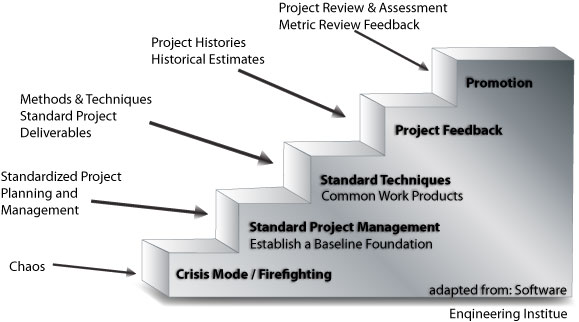 |
 |
A5.1 Capability Maturity Model (CMMI)
(A5.1.P1)
The Capability Maturity Model describes a continuum of five stages based on how well a company or organization follows common and repeatable processes to get work done. The low end of the scale describes companies without repeatable processes, where much of the work is chaotic and ad-hoc. The highest end describes companies that use defined and repeatable processes, collect metrics to help them continuously improve their processes, and look for creative ways to do things better on an ongoing basis.
The CMM was developed from 1984 to 1987 by Watts Humphrey and the Software Engineering Institute (SEI). The SEI is a part of Carnegie Mellon University. The work was funded, and continues to be funded, by the Department of Defense (DoD), which was originally looking for ways to compare and measure the various contractors that were developing software for the DoD.
In the past, there were a number of different CMM models. These models were combined in 2002 into one integrated model – hence the newer acronym of CMMI. (The “I” means “integrated”.) Although the SEI continues to enhance and expand the scope and breadth of various CMMI models, the primary focus for most companies continues to be the software development world.

The Capability Maturity Model contains five stages to evaluate how sophisticated your organization is in establishing and following standard processes.
The Five-Stage Capability Maturity Model (CMMI) (A5.1.P2 )
There are some slightly different interpretations of the CMMI. Some companies have also identified their own proprietary versions of the CMMI process. However, in general, there are five defined stages.
-
Ad-hoc / crises. Your organization has few common processes. The success of your projects depends on the strength and skills of your people. The organization provides little in a supporting environment to help make all projects successful. Most companies are at this level; although some companies say half-jokingly that they are at a 0 or even a -1 level.
-
Standard project management. Your organization has implemented standard project management processes, and you utilize these common processes on all projects. You are trying to establish a baseline foundation upon which to improve further in the future. Most companies that start down the CMMI path are trying to reach this level.
-
Standard software development. You are trying to achieve standardization in your development process similar to what you did for project management in level 2. This includes common and repeatable software development processes, deliverables, tools, etc.
-
Managed feedback. You collect metrics on all aspects of your project management and development processes. you have a repository of metrics and key learnings on historical projects that can be leveraged by new projects.
-
Optimizing / continuous improvement. you have a closed loop of process execution, measurement and continuous improvement. You continuously use measurement, feedback and creativity to optimize your processes.
Is CMMI Right for You? (A5.1.P3)
Should your company start down the CMMI road? Just as there are real benefits to reusing common software components, there is also value in reusing common processes. Why should every project manager in your company struggle to understand how to define a project and how detailed the schedule should be? Why should project managers struggle to understand how to effectively manage scope, risks and quality? These are not new concepts, even within your own company. These processes should all be defined once at an organizational level and then reused by all project managers.
You can use the CMMI model as your guide as you try to implement common processes. You don’t have to start from level 1 and jump to level 5 in one year. The CMMI scale is a journey. Most companies only want to start by moving to level 2. However, even that short jump is not without pain. In many respects, implementing common project management processes is the most difficult part of the journey. In many organizations, this is the first time people will be asked to follow a common set of processes and many won’t like it. If you can successfully get to level 2, then you should have already established the paradigm shift that will make the transition to level 3 a little easier.
In general then, many companies are seeing that they can drive business value by implementing good, reusable processes throughout their organization. The Capability Maturity Model provides a framework that companies can use to measure themselves on a standard 1 - 5 scale. Most companies today are at level 1 and would love to get as high as level 2. However, there is definitely pain involved. There is pain involved with all culture change initiatives when you ask people to change how they do their jobs. The pain can definitely be worth the gain, if your company can stay focused for the time it will take for the culture change to take effect.
[Previous - A5 TenStep Process Model] [Next - A5.2 Project Management vs. Project Life Cycle]